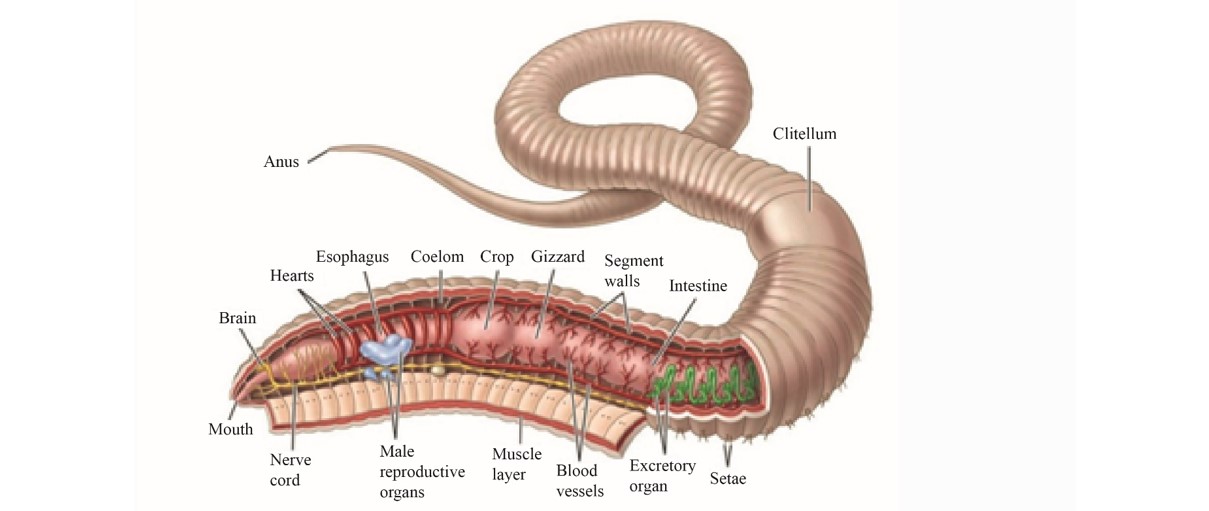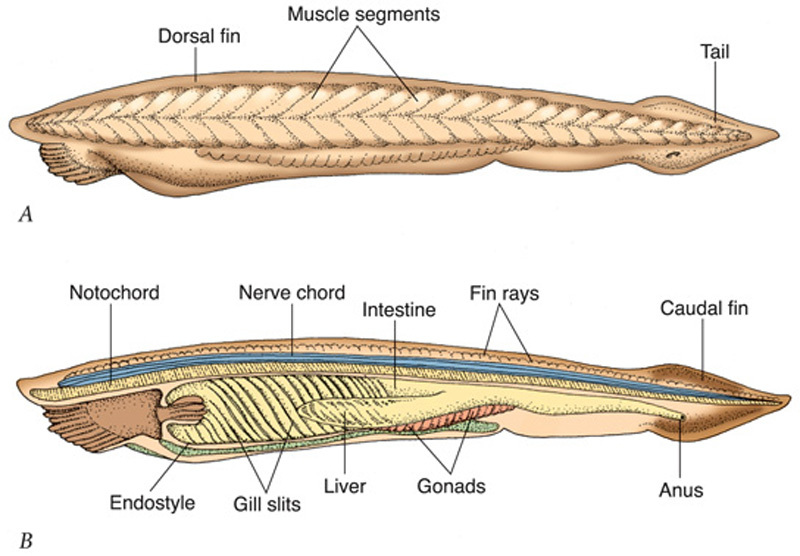
Introduction to Animals
Major Characteristics That All Animals Share:
Kingdom Animalia
So they’ll differentiate on the phylum level
Multicellular
Heterotrophic
Eukaryotic
Lack cell walls
Different Description Types of Animals
Level of Organization
Body Cavity
Number of Tissue Layers
Segmentation
Blastopore: (Protostome or Deuterostome)
Cephalization
Levels of Organization:
Cells
Tissue
Diploblastic or Triploblastic
Organs
Organ systems
Organisms
Simplest animals: just specialized cells to organs to organism
Complex animals: Cell to tissue to organ to system to organism
Just because an animal is more complex than another does not make it a “better” animal. There is no such thing.
Differentiation of Germ Layers: (absent, two, or three)
During embryological development, cells begin to differentiate (activate) into three layers (called germ layers)
Endoderm: Forms digestive and respiratory systems
Mesoderm: Forms muscular, reproductive, circulatory, and excretory systems (muscles)
Ectoderm: Forms nervous and integumentary systems (skin/outer covering)
Classifications:
Diploblastic: having 2 germ layers
Triploblastic: having 3 germ layers
Formation of Body Cavity:
Body Cavity: fluid filled space between digestive tract and body wall
Coelem: complex animals have true body cavity completely lined with mesoderm
In coelemates the endoderm forms a circular digestive tube that is surrounded by a thin layer of muscle
Psuedocoelem: some invertebrates, only partially lined with mesoderm
In psuedocoelemates the endoderm forms a crescent shape digestive tube
Acoelomate: lack coelem between body wall and digestive tract (just a tube of flesh w/ body wall)
In acoelomates the endoderm forms a triangular digestive cavity
All three germ layers are present in each one (just formed differently)
Advantage to having a body cavity: Have room for specialized organs
Blastopore Classification
Blastopore: Opening in blastula
Zygote: fertilized egg that gives rise to blastula
Blastula: hollow ball of cells that eventually folds into itself (creating the beginning of a digestive tract)

Different Groups:
Protostome: blastopore gives rise to the mouth
invertebrates
Deuterostome: blastopore gives rise to anus
Chordates and echinoderms (starfish)
Body Symmetry Classification:
Radial: body parts extend outward from the center
Cnidarians and Echinodermata
Bilateral: body parts have identical left and right sides
Platyhelminthes, Nematoda, Annelida, Mollsuca, Arthropoda, Invertebrate Chordates, and Vertebrates
Asymmetrical: no symmetry
Porifera
Segmentation: repeating parts
Segments can become specialized
Examples: legs, flippers, wings, etc.
Bilaterally symmetrical animals

Cephalization Classification:
concentration of sense organs and nerve cells
Invertebrates:
Invertebrate Characteristics/Overview:
Lack a backbone or vertebral column
Includes 33 phyla (largest group)
Different Phyla Include:
Phylum Porifera
Phylum Cnidarian
Phylum Arthropoda
Phylum Platyhelminthes
Phylum Nematoda
Phylum Echinodermata
Phylum Annelida
Phylum Mollusca
Invertebrate Phylums and Their Individual Classifications Table:
Phylum | Example(s) | Germ Layers | Symmetry | Cephalization | Early Development (Blastopore formation) |
|---|---|---|---|---|---|
Porifera | Sponges | absent | asymmetrical | absent | none |
Cnidarian | Sea Anemones | two | radial | absent | none |
Platyhelminth-es | Flatworms | two | bilateral | present | protostome |
Nematoda | Roundworms | three | bilateral | present | protostome |
Annelida | Earthworms | three | bilateral | present | protostome |
Mollusca | Snails | three | bilateral | present | protostome |
Echinodermata | Starfish | three | radial | absent | deuterostome |
Arthropoda (Largest Phylum) | Crabs | three | bilateral | present | protostome |
(Not Phylum) Invertebrate Chordates | Tunicates | three | bilateral | absent | deuterostome |
Vertebrates(Not Invertebrates) | Birds, Humans | three | bilateral | present | deuterostome |
Quick Sight List:
Phylum Porifera: absent germ layers, asymmetrical, no cephalization, and no blastula rise
Phylum Cnidarians: two germ layers, radial symmetry, no cephalization, and no blatstula rise
Phylum Platyhelminthes: three germ layer, bilateral symmetry, cephalization, a protostome
Phylum Nematoda: three germ layers, bilateral symmetry, cephalization, a protostome
Phylum Annelida: three germ layers, bilateral symmetry, cephalization, a protostome
Phylum Mollusca: three germ layers, bilateral symmetry, cephalization, a protostome
Phylum Arthropoda: three germ layers, bilateral symmetry, cephalization, a protostome
Phylum Echinodermata: three germ layers, radial symmetry, no cephalization, a deuterostome
Invertebrate Chordates: three germ layers, bilateral symmetry, no cephalization, a deuterostome
Vertebrates: three germ layers, bilateral symmetry, cephalization, a protostome
Relationship Between Echinodermata and Chordates:
Invertebrates of the Phylum Echinodermata are the closest cousins to the chordates
Characteristics of All Chordates (that they will exhibit at some point in life):
Dorsal hollow nerve cord: the major cord of nerve fibers running the length of the animal’s body that can develop into the spinal chord in vertebrates
Notochord: supporting rod below the nerve cord that gives rise to the (intervebral disc) in vertebrates
Tail that extends below the anus that gives rise to the (tailbone) in vertebrates
Pharyngeal pouches/sacs: lateral sacs that branch from the pharynx of chordate embryos and may open outside as gill slits in adult fishes (vertebrates) and invertebrate chordates
Difference between Invertebrates and Vertebrates?
Vertebrates are just chordates that have a backbone while invertebrates lack a backbone or vertical column
Diagrams:
Invertebrate Chordates: Cephalochordata:
Body Wall.Body Cavity Diagrams:
Introduction to Animals
Major Characteristics That All Animals Share:
Kingdom Animalia
So they’ll differentiate on the phylum level
Multicellular
Heterotrophic
Eukaryotic
Lack cell walls
Different Description Types of Animals
Level of Organization
Body Cavity
Number of Tissue Layers
Segmentation
Blastopore: (Protostome or Deuterostome)
Cephalization
Levels of Organization:
Cells
Tissue
Diploblastic or Triploblastic
Organs
Organ systems
Organisms
Simplest animals: just specialized cells to organs to organism
Complex animals: Cell to tissue to organ to system to organism
Just because an animal is more complex than another does not make it a “better” animal. There is no such thing.
Differentiation of Germ Layers: (absent, two, or three)
During embryological development, cells begin to differentiate (activate) into three layers (called germ layers)
Endoderm: Forms digestive and respiratory systems
Mesoderm: Forms muscular, reproductive, circulatory, and excretory systems (muscles)
Ectoderm: Forms nervous and integumentary systems (skin/outer covering)
Classifications:
Diploblastic: having 2 germ layers
Triploblastic: having 3 germ layers
Formation of Body Cavity:
Body Cavity: fluid filled space between digestive tract and body wall
Coelem: complex animals have true body cavity completely lined with mesoderm
In coelemates the endoderm forms a circular digestive tube that is surrounded by a thin layer of muscle
Psuedocoelem: some invertebrates, only partially lined with mesoderm
In psuedocoelemates the endoderm forms a crescent shape digestive tube
Acoelomate: lack coelem between body wall and digestive tract (just a tube of flesh w/ body wall)
In acoelomates the endoderm forms a triangular digestive cavity
All three germ layers are present in each one (just formed differently)
Advantage to having a body cavity: Have room for specialized organs
Blastopore Classification
Blastopore: Opening in blastula
Zygote: fertilized egg that gives rise to blastula
Blastula: hollow ball of cells that eventually folds into itself (creating the beginning of a digestive tract)

Different Groups:
Protostome: blastopore gives rise to the mouth
invertebrates
Deuterostome: blastopore gives rise to anus
Chordates and echinoderms (starfish)
Body Symmetry Classification:
Radial: body parts extend outward from the center
Cnidarians and Echinodermata
Bilateral: body parts have identical left and right sides
Platyhelminthes, Nematoda, Annelida, Mollsuca, Arthropoda, Invertebrate Chordates, and Vertebrates
Asymmetrical: no symmetry
Porifera
Segmentation: repeating parts
Segments can become specialized
Examples: legs, flippers, wings, etc.
Bilaterally symmetrical animals

Cephalization Classification:
concentration of sense organs and nerve cells
Invertebrates:
Invertebrate Characteristics/Overview:
Lack a backbone or vertebral column
Includes 33 phyla (largest group)
Different Phyla Include:
Phylum Porifera
Phylum Cnidarian
Phylum Arthropoda
Phylum Platyhelminthes
Phylum Nematoda
Phylum Echinodermata
Phylum Annelida
Phylum Mollusca
Invertebrate Phylums and Their Individual Classifications Table:
Phylum | Example(s) | Germ Layers | Symmetry | Cephalization | Early Development (Blastopore formation) |
|---|---|---|---|---|---|
Porifera | Sponges | absent | asymmetrical | absent | none |
Cnidarian | Sea Anemones | two | radial | absent | none |
Platyhelminth-es | Flatworms | two | bilateral | present | protostome |
Nematoda | Roundworms | three | bilateral | present | protostome |
Annelida | Earthworms | three | bilateral | present | protostome |
Mollusca | Snails | three | bilateral | present | protostome |
Echinodermata | Starfish | three | radial | absent | deuterostome |
Arthropoda (Largest Phylum) | Crabs | three | bilateral | present | protostome |
(Not Phylum) Invertebrate Chordates | Tunicates | three | bilateral | absent | deuterostome |
Vertebrates(Not Invertebrates) | Birds, Humans | three | bilateral | present | deuterostome |
Quick Sight List:
Phylum Porifera: absent germ layers, asymmetrical, no cephalization, and no blastula rise
Phylum Cnidarians: two germ layers, radial symmetry, no cephalization, and no blatstula rise
Phylum Platyhelminthes: three germ layer, bilateral symmetry, cephalization, a protostome
Phylum Nematoda: three germ layers, bilateral symmetry, cephalization, a protostome
Phylum Annelida: three germ layers, bilateral symmetry, cephalization, a protostome
Phylum Mollusca: three germ layers, bilateral symmetry, cephalization, a protostome
Phylum Arthropoda: three germ layers, bilateral symmetry, cephalization, a protostome
Phylum Echinodermata: three germ layers, radial symmetry, no cephalization, a deuterostome
Invertebrate Chordates: three germ layers, bilateral symmetry, no cephalization, a deuterostome
Vertebrates: three germ layers, bilateral symmetry, cephalization, a protostome
Relationship Between Echinodermata and Chordates:
Invertebrates of the Phylum Echinodermata are the closest cousins to the chordates
Characteristics of All Chordates (that they will exhibit at some point in life):
Dorsal hollow nerve cord: the major cord of nerve fibers running the length of the animal’s body that can develop into the spinal chord in vertebrates
Notochord: supporting rod below the nerve cord that gives rise to the (intervebral disc) in vertebrates
Tail that extends below the anus that gives rise to the (tailbone) in vertebrates
Pharyngeal pouches/sacs: lateral sacs that branch from the pharynx of chordate embryos and may open outside as gill slits in adult fishes (vertebrates) and invertebrate chordates
Difference between Invertebrates and Vertebrates?
Vertebrates are just chordates that have a backbone while invertebrates lack a backbone or vertical column
Diagrams:
Invertebrate Chordates: Cephalochordata:
Body Wall.Body Cavity Diagrams:
 Knowt
Knowt